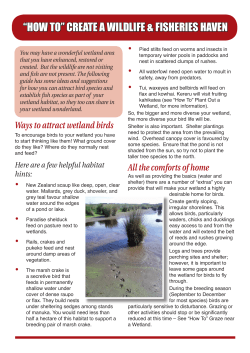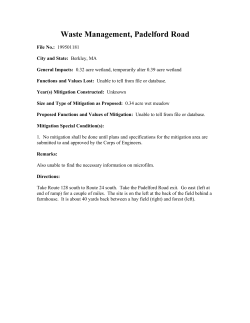
Endangered Species VOICE 2 - Sangat Development Foundation
Endangered Species Voice Weekly Bulletin Vol: 1 NO: 11 October 2014 BY: SANGAT DEVELOPMENT FOUNDATION Endangered Species Voice: Sindh-Pakistan Weekly Monitoring Bulletin 2014 1. Deh Akro-II Desert Wetland Complex is located in District Benazirabad (Nawabshah) Sindh, Pakistan patches of irrigated agricultural fields lying adjacent to the desert. Deh Akro-II wetland fauna includes waterbirds, crocodiles, otters and fish. In 1988, the wetland was declared a Wildlife Sanctuary. Its total area is 20,500 ha. Deh Akro-II Wildlife Sanctuary is considered internationally important, and the wetlands complex was declared as Ramsar on 5 November 2002, It represents the example of a natural inland wetland Deh Akro-II desert wetland complex is eco-system consist of 38 lakes and is a located in district Shaheed Benazirabad unique desert habitat (Nawabshah). It is a which supports large The IUCN Red List of natural wetlands variety of fauna and complex comprising 32 Threatened Species flora species mainly lakes and a complex of desert and wetland four major habitats Marsh crocodile habitats. Many rare and types, desert, wetland, (Crocodylus palustris), endangered wildlife marsh and agricultural Status: Vulnerable A1a, species also breed in this lands. The wetland C2a ver. 2.3 area. complex has a unique Houbara bustard The plant species found example of desert (Chlamydotis undulata), in the sanctuary include wetland ecosystem that Status: Vulnerable Prosopis cineraria, hosts a variety of rare A2bcd+3bcd+4bcd Prosopis juliflora, and endangered wildlife ver. 3.1 Acacia jacquemontii, species. Deh Akro-II Marbled teal Acacia nilotica, Aerva wetland supports more (Marmaronetta javanica, Salvadora than 18 species of angustirostris), Status: oleoides, mammals, 16 species of Vulnerable Capparisdecidua, Cassia reptiles, 14 species of A2cd+3cd+4cd ver. 3.1 sp, Calligonum fish, and 101 species of White-eyed pochard polygonoides, birds and regularly (Anthya nyroca) Status: Euphorbia prostrata, supports over 20,000 Near Threatened Saccharum spontaneum, waterbirds. This site also ver. 3.1 Saccharum bengalensis, supports a small Tamarix aphylla, population of marsh crocodiles. It is an Zizyphus maauritiana, Zizyphus important feeding and spawning ground nummularia, Alhagi maurorum, Indigofera for several indigenous fish species. The sp., Phyla nodiflora, Typha domingensis, desert is characterised by sand dunes Tpypa elephantina, Achyranthes aspera, with well developed herbs/shrubs and Calotropis procera, and Tamarix indica. trees. The agricultural land comprises Endangered Species Voice: Sindh-Pakistan Weekly Monitoring Bulletin 2014 Reed vegetation and Tamarix spp can be observed at the margins of these lakes. The lakes support a good population of waterfowl, marsh crocodiles, otters and fishes. About 1% of the global population of the threatened marbled teal breeds in these lakes in May to July. The water levels of these lakes increase and decrease due to the fluctuations in the water levels of Jamrau and Nara canals. Low rainfall has a significant impact on these wetlands. Some of the wetland flora species are Farsetia hamiltonii, Limeton indicum, Tribulus longipetalus, Cynodon dactylon and Stipagrostis plumose. Noteworthy fauna Important wildlife species in the sanctuary area can be classified as follows: Rare: Desert cat (Felis lybica), Fishing cat (Felis viverrina), Darter or Snake bird (Anhinga melanogaster pennant), Garganey (Anas querquedula), Spoonbill (Platalea leucorodia), Black ibis (Pseudibis papillosa). Endangered: Marsh crocodile (Crocodylus palustris), Houbara bustard (Chlamydotis undulata), Marbled teal (Marmaronetta angustirostris), White-eyed pochard (Anthya nyroca). Abundant: Grey partridge (Francolinus pondicerianus), Black partridge (Francolinus francolinus), Mallard (Anas platyrhynchos), Pintail (Anas acuta), Gadwall (Anas strepera), Common coot (Fulica atra), Indian moorhen (Gallinula chloropus), Black-winged stilt (Himantopus himantopus), Shoveler (Anas clypeata ), Little egret (Egretta garzetta), Intermediate egret (Egretta intermedia), Indian pond heron (Ardeola grayii), Grey heron (Ardea cinera), Redshank (Tringa totanus), Indian roller (Coracias benghalensis), Glossy ibis (Plegadis falcinellus), Common pochard (Aythya ferina), Common teal (Anas crecca). Marsh crocodile Marsh (or Mugger) crocodile has been declared an endangered species. Previously, Muggers and Gavials inhabited Nara canal (Old Hakra River) and its tributaries, but after the emerging of these wetlands through seepage from Nara canal during the early 1950s, crocodiles have taken refuge in these lakes and are now breeding successfully. Gavial is now extant from Nara canal and from the wild in Pakistan since 1976. Nara canal has a crocodile population of about 200-250, Endangered Species Voice: Sindh-Pakistan Weekly Monitoring Bulletin 2014 while the estimated population of crocodiles in the wetland complex of Deh Akro-II Wildlife Sanctuary is believed to be between 550-600 animals. These crocodiles permanently inhabit these lakes year round. The wetland supports diverse fauna and flora, mainly desert and wetland habitat. This unique desert wetland ecosystem supports more than 18 species of mammals, 16 species of reptiles including threatened Marsh Crocodile, 14 species of fishes and 101 species of birds. The resident and migratory populations of all the species are dependent of this wetland system for survival in different time of their life It regularly supports more than 20 thousand waterfowls and other birds of different species. (Please refer to Sindh Wildlife Waterfowl Counts 1992-2000.) This wetland complex supports 6% of the relevant bio-geographic population of Marbled teal. (Marmaronetta angustirostris). More than 300 birds were count regularly each year and some also breeding in the wetland complex. This wetland complex supports a significant proportion of species such as Dambro/Rohu (Labeo rohita), Thaila (Catla catla), Morakha (Cirrhinus mrigala), Singhara (Mystus seenghala), Malli/Jerki (Wallago attu), Gandan (Natopterus notopterus) and Dimmon (Ompok bimaculatus) which are food source of Marsh Crocodile and local resident communities. All the fishes are totally dependent on these wetlands as spawning ground, for their food source and as nursery. The local community of Deh Akro-II desert wetlands is poor and mostly dependent on the natural resources of wetlands for their livelihood purposes, even these natural resources are not sufficient enough for their livelihood means in the long run. Due to the unsustainable use by the local community as well as by the Endangered Species Voice: Sindh-Pakistan Weekly Monitoring Bulletin 2014 outsiders of the natural resources of Deh Akro-II wetlands complex, have largely degraded and diminished to the natural Animal theft, however, was common at the place, sources said, while the official in charge of the facility told Dawn that an inquiry into the issue had been ordered. Last year two pythons — a 17-foot-long reticulated python and a 12-foot-long albino reticulated python — went ‘missing’ at Safari Park where they had been brought from the zoo for a pet show on Eid. The zoo administration declared them dead only after keeping a mysterious silence over the issue for three months. Both the zoo and Safari are managed by the Karachi Metropolitan Corporation. habitats of the wetlands, which pose a great threat to the wildlife of the area. The local community and outside hunters have now been potential threat to the marsh crocodile and permanent and migratory birds. 2. Five pelicans Safari Park ‘missing’ at go By Faiza Ilyas KARACHI: Five pelicans have gone ‘missing’ during the Eid holidays at Safari Park despite the fact that all pelicans kept at the facility were pinioned to prevent their flight, it emerged during a visit to the Safari on Saturday. Interestingly, the recently appointed official in charge of Safari Park Mugheera Qadri claimed that he had no report about some pelicans being missing. “In fact I am thankful to you for bringing this issue to my knowledge,” he said, adding that an inquiry had been ordered to ascertain the facts. Mr Qadri said three pelicans had recently been separated from the flock for pinioning. The surgical procedure was required every two months as feathers were grown fast, he explained. “I think the birds are being kept in a clinic,” he said when asked about the place where they were being kept for pinioning. Safari Park, according to the sources, had no facility for keeping animals for medical treatment. “I am not sure about the exact species the birds belong to but I can tell you after asking the staff concerned,” he said while responding to a question about the pelican species. Endangered Species Voice: Sindh-Pakistan Weekly Monitoring Bulletin 2014 According to the sources, Safari Park’s collection of pelicans rose to 21 last winter after five of them attracted to its lake were captured by its staff. Previously, the park had received a donation of 16 birds — 10 dalmatian pelicans and six rosy pelicans. All the 21 birds later were pinioned and released into the lake. While five of them died during the past one year, the park is left with only 11 pelicans at present, raising questions about at least five other pelicans which are said to be missing. The issue of donation of 16 pelicans to Safari Park had also stirred a controversy, for pelicans are protected under the Sindh Wildlife Ordinance, 1972 and only a person with a licence can keep the birds. Sources in the wildlife department at that time had stated that no permit for keeping pelicans in captivity had been issued since long. The donor, however, claimed that many of the birds were either donated by individuals who were finding it difficult to manage them or were born at his farm. Pelicans, according to wildlife experts, do not breed easily as people generally lack the basic knowledge of their management and failed to provide animals the right habitat. “They are migratory birds and it has never been heard that a local resident population of the bird has developed at our lakes in the interior of Sindh. The zoo gets these birds from poachers. Only two baby pelicans were said to have survived at the zoo in two decades,” a senior zoo official told Dawn. Endangered Species Voice: Sindh-Pakistan Weekly Monitoring Bulletin 2014 According to the information available on the internet, the rosy pelicans (Pelecanus onocrotalus) also known as the great white pelican, the eastern white pelican or white pelican breeds from southeastern Europe through Asia and in Africa in swamps and shallow lakes. The dalmatian pelican (Pelecanus crispus) breeds from south-eastern Europe to India and China in swamps and shallow lakes. This huge bird is the largest of the pelicans and one of the largest living bird species. The diet of both species of pelicans mainly consists of fish. http://www.dawn.com/news/1137362/ five-pelicans-at-safari-park-go-missing Published in Dawn, October 12th, 2014 About SANGAT SANGAT Development Foundation (SANGAT) is a not for profit and nongovernmental organization entity launched by a group of young community development professionals, conservationists, academicians and environmentalists. SANGAT is engaged in advocacy, campaigning, community awareness, mass mobilization for wetlands rehabilitation and conservation of fauna and flora of Deh Akro-11 desert wetlands complex Nawabshah, Sindh, Pakistan. SANGAT IS MEMBER OF: 1. Living Lakes Network http://www.globalnature.org/LIVI NG-LAKES/Asia/Deh-AkroWetlands 2. World Wetlands Network (WWN) http://new.wwt.org.uk/deh-akroiiPakistan Endangered Species Voice: Sindh-Pakistan Weekly Monitoring Bulletin 2014 3-SANGAT Partners Endangered Species Voice: Sindh-Pakistan Weekly Monitoring Bulletin 2014
© Copyright 2025










